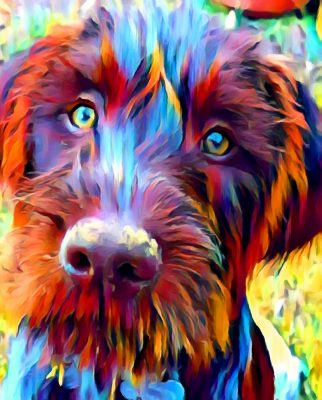
When few examples of a breed can be seen due to its uncommonness, and there are no disqualifications in the standard, it can be challenging to judge. Some would advise that at such times, the best way to evaluate the dog is to prioritize by its function.
We came across an old article about the German Wirehaired Pointer, and it serves as a reminder of the importance of “function” when evaluating this breed. This is a practical breed developed by practical people who needed a “Swiss army knife” of a dog to do all the jobs they needed to have done: Find game. Point to it. Bring it back. Do it with wounded game. Do it with feathered game. Do it with furry game. Do it on land. Do it in water. Do it all.
With this in mind, an obvious place to start one’s assessment is with coat. The operative word in the breed’s name is “wirehaired,” and anything less cannot protect a dog in dense harsh cover or cold water. Another key word is “Pointer,” which, no pun intended, points to a dog expected to live up to its role as a HPR (hunt-point-retrieve) gundog. As such, the dog needed to be built for efficiency, endurance, and all the specifications inherent in its job: Well laid back shoulders to cover ground, and hindquarters to balance the equation. A short strong back to help support a neck of sufficient length and strength necessary to hold up a head. A set of sturdy jaws carrying a big bird or small game, sometimes a wet one which made it heavier. Close fitting eye rims to protect the eyes from irritating plants such as burdock or fuchsschwanz (foxtail). A muzzle roughly the same length as the head to provide extra area for scent receptors. Tight skin, an antidote to sagging skin that could trap moisture and bacteria, detrimental to a dog that spends time in water. Figuratively speaking, the “devil is in the details,” and the tiny strokes of wording in the breed standard provided the blueprint for breed type.
To develop a dog that could work in German fields, forests, and lakes, the “recipe” breeders used to create the breed included the Deutsch Kurtzhaar (German Shorthaired Pointer), Stichelhaar, Pointing Griffon, and Pudelpointer. Always was an adherence to the ideal: “Through performance to standard” as postulated by Freiherr Sigismund of Zedlitz and Neukirch, aka Hegewald, the initiator of testing working dogs for hunting. It became the principle of the Verein Deutsch Drahthaar, e.V. (VDD), a breed organization establish in 1902, and it is still upheld today. Little surprise that this dedication to early principles resulted in the German Wirehaired Pointer being the most frequently used hunting dog by the hunting establishment in Germany today.
We can’t conclude without mentioning that the breed is also known as the Deutsch-Drahthaar. However, there is a school of thought that the Drahthaar and GWP are two distinct breeds, and this article written in 2014 offers a point of view supporting this thinking. We’re interested in the opinions of other breed owners.
Image: German Wirehaired Pointer by Chris Butler is available for purchase as fine art, and in lifestyle and home decor items here
